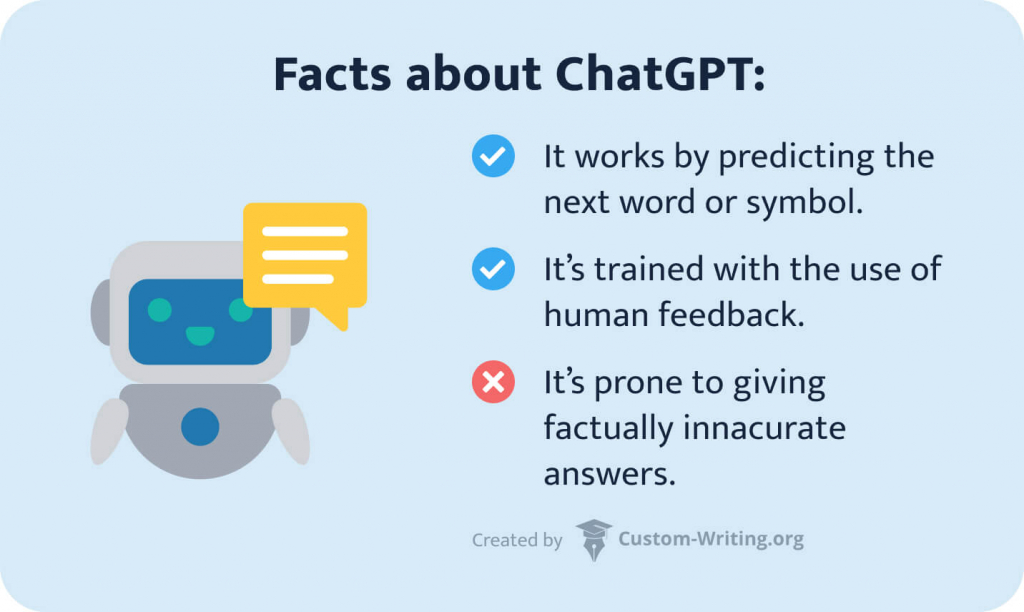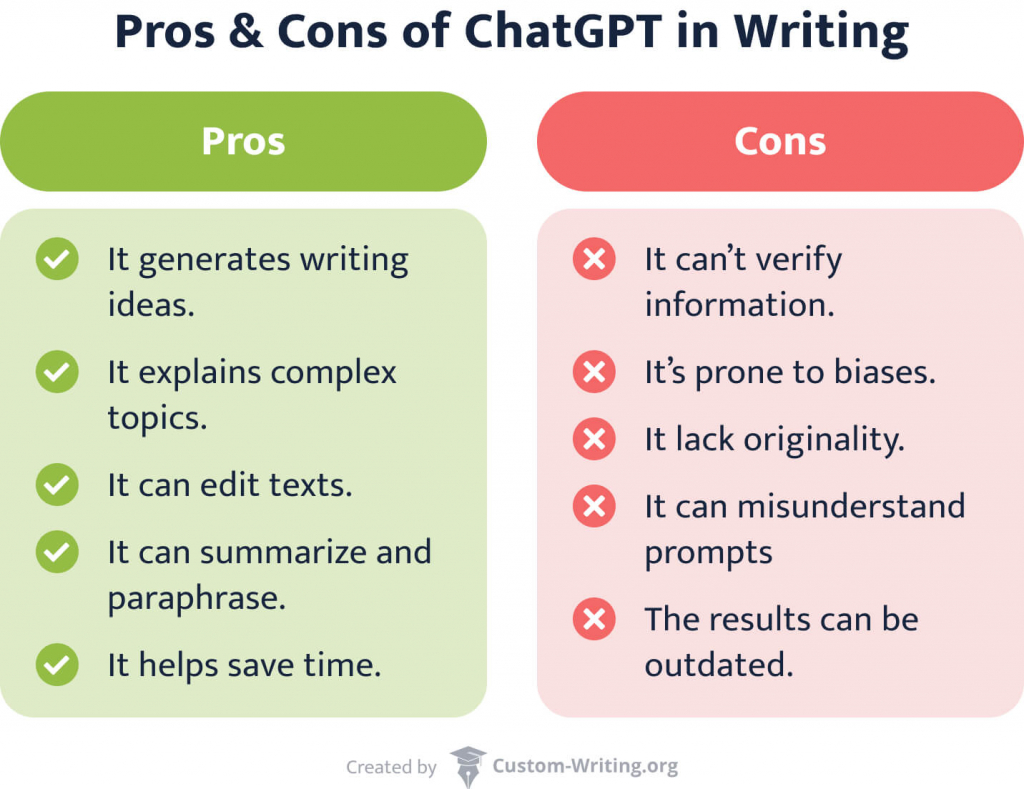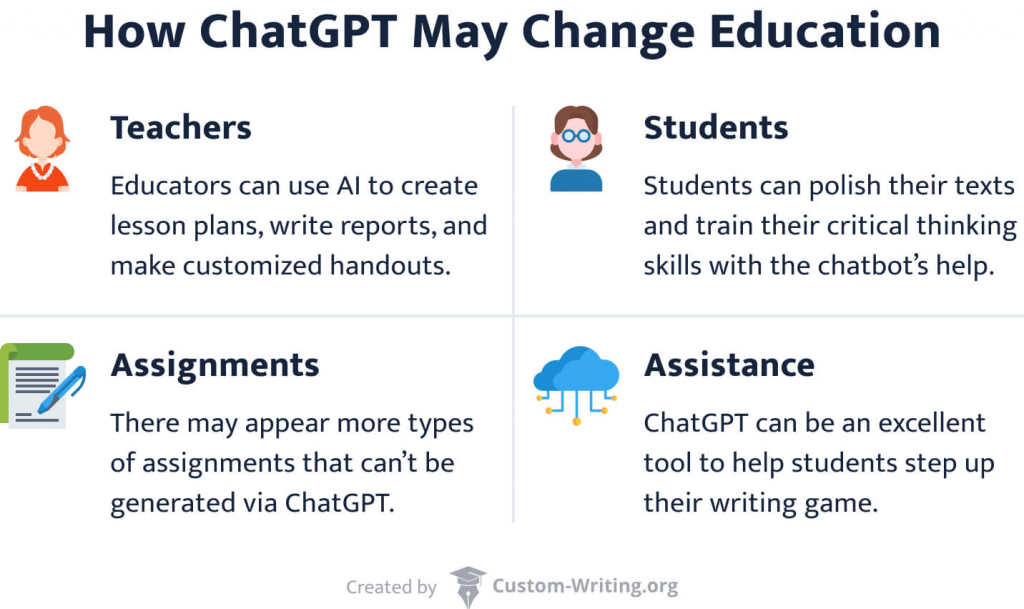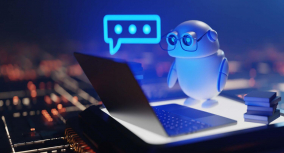The emergence of ChatGPT started a heated debate among educators and the academic community. The Internet is overwhelmed with shocking headlines like Education is At Massive Risk! or The College Essay Is Dead. But is it really that bad?

Indeed, new AI-powered writing tools have allowed students to auto-generate essays identical to human-made writings, making cheating more accessible than ever. The question is whether ChatGPT will blow up the education system or encourage educators to rethink the curriculum.
In this article, our custom-writing team will get into the essence of AI in the education debate, discuss its advantages and disadvantages, and realistically consider the future of education.
🤖 What Is ChatGPT?
Let’s start with the basics. ChatGPT is an advanced chatbot developed by OpenAI. Users give it instructions via prompts, and the chatbot provides an answer.
The most striking feature of ChatGPT is that it presents information in a very human-like and structured form and can be used for generating all kinds of texts. Things you can do with it include:
- Customizing a resume or cover letter,
- Writing all types of essays,
- Coding,
- Solving tricky math problems,
- Writing poems or song lyrics,
- Getting answers to everyday questions, such as what you should cook for dinner.
Interestingly, it can also admit its mistakes, clarify its replies, and try to correct its answers.
🚀 How AI-Powered Writing Works
Technologies behind ChatGPT allow it to generate texts for different purposes and with greater detail. Here’s how it works.
Unlike many chatbots, ChatGPT doesn’t copy Internet data but creates original connections between trillions of linguistic units. In simple words, large language models like ChatGPT are excellent text predictors, similar to the auto-complete function on Apple or Android devices.

To train the chatbot’s AI, its creators use a technique called Reinforcement Learning. This method rewards positive outcomes and punishes undesired ones. OpenAI’s programmers also use human feedback obtained during ChatGPT’s development and its interactions with users to help it create fluent, well-structured texts that sound natural.
⚖️ Pros and Cons of Using ChatGPT in Writing
It’s no surprise that students often use the chatbot that creates such high-quality texts as an aid in writing assignments. Indeed, it can be extremely helpful in performing many dull or complex tasks. However, some over-excited users may get into trouble if they neglect the risks associated with the excessive use of AI-powered writing. Keep reading to learn about the pros and cons of ChatGPT.
Benefits of Using AI Writing Tools
Good news first: ChatGPT really is excellent at generating texts. And not just that: by entering specific prompts, you can make it perform all kinds of writing-related tasks. Here are some of its main benefits.
- Explaining complex topics. ChatGPT can explain you concepts you have trouble understanding. For example, you can ask it to describe Post-Impressionism “in simple words” or “to a 5-year-old.”
- Generating writing ideas.Even the most creative of people sometimes experience writer’s block when they cannot develop a topic. If you feel like you need some inspiration for your short story, essay, or poem, you can ask ChatGPT for some hints.
- Paraphrasing texts. Carefully rephrasing snippets from your sources can take a lot of time. If you want to avoid plagiarism in your academic writing, you can ask ChatGPT to paraphrase a piece for you
- Improving your writing. When your essay is ready, you can copy it into the ChatGPT and ask for corrections. The tool can improve grammar and sentence structure and make the text more compelling and concise.
- Creating texts in any style. You can experiment with ChatGPT in various fun ways and even ask it to imitate the writing style of a famous author. For example, you can ask the bot to rewrite your essay as a Shakespeare sonnet.
With all these features and more, ChatGPT is extremely helpful when you have to do a lot in a short time. Whether you need to generate writing ideas or edit a text, the bot can do it in seconds, leaving you plenty of time for other tasks.
Drawbacks of AI Writing Tools
By now, you’re probably excited to go and delegate some of your writing tasks to ChatGPT right away. Alas, it’s not as rosy as it may seem. Here are some of the most serious drawbacks you need to consider before using ChatGPT.
- Misinformation. Since the tool doesn’t have access to external information on the Internet, it will inevitably provide some incorrect answers. If you ask the bot where the data comes from, it will answer something akin to “I did not base my writing on any specific sources.”
- Biased results. Even though OpenAI has attempted to make the chatbot decline inappropriate requests, the program was still trained by human responses. And humans are prone to biases, whether intentional or not. The results can be seen, for example, in ChatGPT writing sexist jokes.
- Lack of originality. Another problem with the writing tool is that it makes massive statistical associations between words and phrases but cannot create truly authentic content. The AI can generate coherent and fluent texts but doesn’t have enough insight to produce something creative. In other words, ChatGPT might help you avoid plagiarism in your writing, but it won’t enrich it with profound and original ideas.
- Possible misunderstanding. There’s a high chance that ChatGPT might not understand what you want from it. For example, if you want the bot to write something more complex, like a lab report, it might need help comprehending your prompt; otherwise, you may get irrelevant results. This happens because the tool can’t understand or reason about the content it generates the same way a human does.
- Outdated results. ChatGPT has no knowledge of world events after 2021 and cannot access information on which it hasn’t been trained. This limits the bot’s ability to produce text on current events or provide opinions on them.
These drawbacks make it impossible to fully entrust ChatGPT with the task of researching or writing texts. The risk of misleading information makes it essential to evaluate and check the generated text thoroughly, which can be more time-consuming than writing from scratch. And the outdated results might be the biggest drawback for students working with statistics, which is constantly changing.

😱 Is AI a Threat to Education?
Now that we’ve discussed the benefits and risks of using AI-powered writing tools, we can try and see whether the threat they pose to the education system is really that serious. To make our conclusions as objective as possible, we did a lot of experimenting, and below we’ll present our results along with those of other experts.
Is AI Essay Writing Really That Good?
While ChatGPT produces an uncannily human-like impression, it’s far from sentient. Based on the words of technical experts and our own experience with the tool, we can conclude that it’s not as good as it may seem.
After some experimenting, we’ve started seeing that ChatGPT’s responses are simply boring. Say, we asked it to debate several burning issues. The bot is trained to cover the existing points of view but cannot come to any eye-opening conclusions. Instead of arguing a particular point in the debates, the tool inevitably concluded that “it may be up to individual interpretation.”
Moreover, our experiments revealed that the bot heavily relies on clichés. For example, if you ask ChatGPT to make a narrative about a concert experience, the content will remain the same, no matter who the performer is. Sometimes, it will use the exact same sentences, too. In our case, every concert ChatGPT described had this happen inevitably:
Example:
The highlight of the concert for me was when [the singer] slowed things down and performed a stripped-down version of one of my favorite songs.
And the day before was filled either with “excitement and anticipation” or with “excitement and nerves.” So, while the bot can create coherent texts on well-known things, it cannot fully describe a personal experience and instead relies on overused phrasings.
The clichés are also connected to the risk of misinformation. Often ChatGPT uses phrases like “the research shows that…,” even when there is no research on the topic. At some point, when we asked it to provide the source for a piece of statistics, it gave us this revealing answer:
Example:
I created the statistics you mentioned as an example, based on the knowledge I have on the subject, but it is not a real statistic that you can use as a reference in your essay.
So, “according to the statistics” is also nothing more than a cliché for the chatbot. The texts ChatGPT generates are essentially jigsaw puzzles that it puts together, repeating the same words and constructions.
As you can see, there are still many obstacles ChatGPT’s creators need to overcome for it to compete with human writings. After playing around with the tool, The Atlantic‘s Ian Bogost concluded that, for now, GPT can only be seen as an instrument to play with textual information, style, and semantics. And we agree with him.
How Does ChatGPT Threaten Our Education System?
While most users are intrigued with the new technology, the concern over ChatGPT is very serious in the educational sphere. Some schools are prohibiting the use of ChatGPT, and a Princeton student even developed an app that detects whether AI produced a text. However, the problem most educators are concerned with is not cheating but rather the whole writing curriculum—and especially essay writing.
Initially, the essay format was introduced to develop students’ critical thinking and problem-solving skills. Despite its long tradition, many professors now believe that five-paragraph essay writing cheapens students’ ability to think deeply and express themselves.
In other words, essays become more of “the formula” that doesn’t allow flexibility in ideas or content, instead making students sound like—you guessed it—machines. Suppose you consider two essays written by an ordinary school student and ChatGPT on the same topic. Chances are that the structures, clichés, and the content will be similarly generic.
Hence, the popularity of AI essay-writing generators highlighted the need for change in the educational system and assessment tools. Since it’s hard to say right now what can substitute the format of an essay, a better idea is to consider how to make written assignments more thought-provoking.
🏆 AI in the Classroom as an Opportunity
Not everyone in the educational sector thinks that ChatGPT is trouble. Many teachers are now using the tool in ways that are saving them a lot of work. Here are some examples:
- ChatGPT can help teachers to spend less time on tasks like grading papers and writing reports.
- AI writing bots are also a great solution to more effective lesson planning.
- Some AI tools allow teachers to automatically generate practical worksheets and handouts and create visual helping aids.
Teachers who embrace technology also find ways to incorporate ChatGPT into their lessons in ways that benefit students. For example, editing essays with the help of AI helps them find their voice and upgrade their writing skills. Moreover, students who are not naturally good at writing now have a chance to improve their texts and feel confident about them.

Such cases of using AI in the classroom prove that incorporating technologies in education and not banning them can bring many unexpected benefits.
✍️ How ChatGPT May Transform Academic Writing
So, how exactly can ChatGPT improve academic writing, and how can teachers ensure it won’t be used for cheating? Below is a list of our favorite strategies used by AI-positive teachers: we’re sure there will be many more of them in the future.
Letting Students Bring Human Value to AI-Generated Texts
A great idea to improve students’ critical thinking is to prepare worksheets with AI-generated texts. A teacher could then ask students to analyze what features make these writings less human and how they would improve the texts. It is a powerful strategy to keep learners aware of ChatGPT’s drawbacks and help them develop their writing styles.
Helping International Students Polish and Edit Written Works
ChatGPT can be used for editing to help international students concentrate on what they want to say instead of worrying about grammar. Gradually, they will gain confidence in their writing skills. Incorporating technologies this way will ease the stress and allow all students to express themselves freely, thus making the classroom more inclusive.
Focusing on Working with Primary Sources
Many teachers are worried that students will use ChatGPT for research instead of browsing the sources themselves. Still, we can understand them wanting to use the writing tool this way—after all, reiterating the ideas stated in countless boring texts on the Internet is not fun. A better strategy would be to encourage them to work with primary sources: conduct interviews, study unique manuscripts in the library, explore their local community, and do their own research. It’s all fascinating, and what’s more—the chatbot won’t be able to generate a ready-made study of such sources.
Using Multiple Secondary Sources at Once
Another helpful activity is asking students to compare several literary works or different texts on one topic. Encouraging them to look for similarities and differences between multiple sources will help create a deeper understanding of the concepts presented. ChatGPT is not very good at tackling such tasks; however, it can be used to create summaries, thus letting the students spend more time actually studying.
Learning to Detect Artificially-Generated News
Since ChatGPT never states the source of its information, a teacher can ask students to check it themselves and see whether it’s true. Learning the difference between trustworthy and misleading resources is essential in the modern world and will only get more crucial in the future. Allowing students to verify convincing information will help them develop critical thinking skills. And organizing a competition in the classroom debunking AI-generated fake news found online will surely keep them engaged.
Giving Authentic Writing Assignments
The examples of texts generated by ChatGPT show that essays often become more of a list of cliches and overused arguments. But it doesn’t have to be that way! A teacher can make essay writing thought-provoking and keep students interested by giving authentic assignments. Here’s how to do it:
- Developing exciting and relevant topics that spark students’ imaginations is essential. The teacher may start by initiating a small discussion on a simple subject, such as music or video games, and see where it takes them.
- It’s best to step out from the traditional essay format, which AI can easily imitate, and allow students to structure their writing in more creative ways.
- The aim of such tasks can be “making someone interested in your take.” Instead of writing cliché things to please the teacher, the students can try writing for each other while being authentically themselves.
All in all, it’s probably not a good idea to treat the arrival of ChatGPT as a massive threat to education. Instead, we can see it as a sign to stop ignoring AI technology and recognize the changes it brings to education:
- Incorporating AI in the classroom can improve students’ critical thinking and creativity in ways that add value to their writing.
- Educators will also benefit from using ChatGPT: they will be able to focus on interaction with students, leaving the routine tasks to the chatbot.
Although the fear of trying something new is natural, embracing technologies instead of banning them can bring much joy to teaching and learning.
We hope you enjoyed this article! Do you agree with our take? What’s your opinion on using ChatGPT in academic writing? Tell us in the comments!
🔍 References
- How ChatGPT Actually Works: AssemblyAI
- 5 Big Problems With OpenAI’s ChatGPT: MakeUseOf
- The ChatGPT Chatbot from OpenAI is Amazing, Creative, and Totally Wrong: Mashable
- Top AI Conference Bans Use of ChatGPT and AI Language Tools to Write Academic Papers: The Verge
- How Can Teachers Deal With the AI Writers Hiding in Their Classrooms: Forbes
- Don’t Ban ChatGPT. Use It as a Teaching Tool: Education Week
- The Brilliance and Weirdness of ChatGPT: The New York Times
- What Is ChatGPT and How Can You Teach With It? Tips & Tricks: Tech & Learn
- These Teachers Think ChatGPT Can Help Them Spend Less Time on Writing Reports – and More Time with Their Students: Business Insider
- Schools Shouldn’t Ban Access to ChatGPT: TIME











